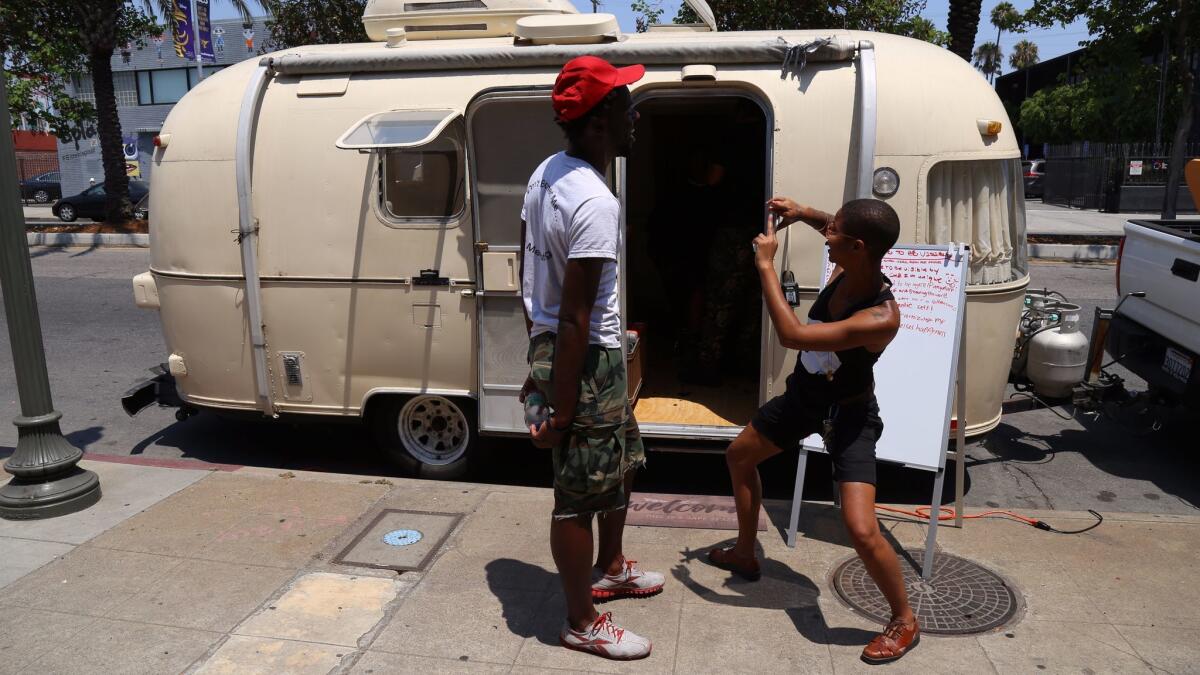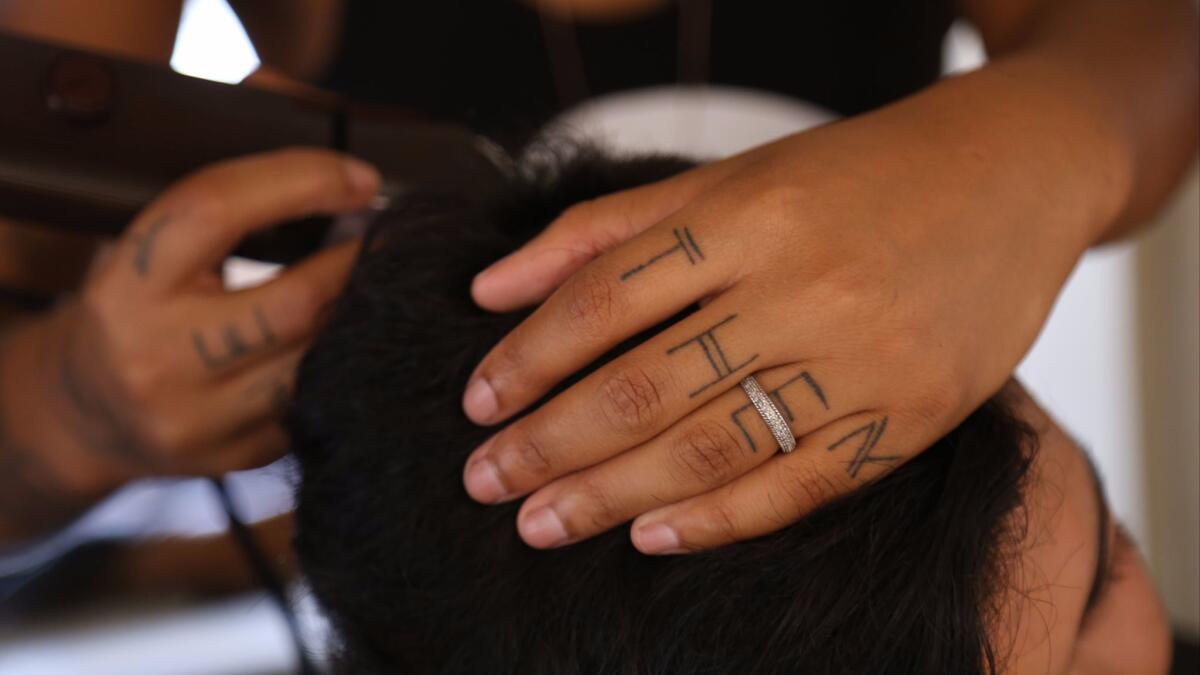Genderqueer hairstylist provides a safe space for LGBTQ youth in a mobile salon

Madin Lopez, a genderqueer hairstylist and founder of the nonprofit Project Q, cuts hair in a vintage Airstream trailer outside the Los Angeles LGBT Center’s Youth Center in Hollywood. (Claire Hannah Collins / Los Angeles Times)
- Share via
The young, black transgender woman in hairstylist Madin Lopez’s chair used to hate getting her hair cut. Barbers always questioned her gender identity. They always cut her hair short. She’d always be disappointed.
But on a recent, sweltering afternoon, Lopez put a small plait across 23-year-old Kaityanna Phillips’ forehead. Phillips had been growing her hair out, and this was the first time it had ever been braided. She couldn’t stop running her hand over it.
“Coming here, the light comes back into me again,” Phillips said, sighing happily.
‘Here’ is Lopez’s beige 1977 Airstream trailer-turned-barbershop parked on a bustling Hollywood street near the Los Angeles LGBT Center’s Youth Center.
Twice a month, Lopez — who is genderqueer, identifying neither as male nor female — gives free haircuts to dozens of young LGBTQ people, offering them a space where their identity is not only respected but also discussed openly.
Lopez asks each new person: What are your preferred gender pronouns? The words ‘THEY’ and ‘THEM’ — the stylist’s preferred pronouns — are tattooed across Lopez’s fingers.
Lopez, 30, runs a free haircutting operation through a small nonprofit called Project Q, the ‘Q’ standing for queer. Many of the young people whose hair they cut are homeless or struggling. Many are just kids trying to figure out who they are.
“Having a bad-ass haircut is so empowering, to feel like you own everything in your space, to feel like you can take up space,” said Lopez, who also works in an Echo Park salon.
“When you don’t feel good about yourself, you cower. You hold yourself down. … I wanted to give confidence to people that needed the ego boost.”

Working from experience
The hairstylist knows what it’s like to be young, black, queer and unaccepted.
Growing up in Los Angeles, Lopez was about 12 when they started understanding they were different. Britney Spears came on TV, and Lopez, who then identified as female, thought, “Oh, I see why people say she’s attractive.”
Lopez asked family members what they’d do if Lopez were gay.
“They said they’d pretty much beat it out of me, and they did,” Lopez said. “It’s interesting when you start realizing something about yourself and your very black, very Christian family is like — no.”
Lopez was physically abused. Then kicked out. The child cycled through foster homes, living first with a a white foster family, then an Asian family. Neither knew how to care for Lopez’s hair.
“My hair was breaking off, getting shorter and shorter because no one knew what to do. … Literally inches of my hair were falling off,” Lopez said.
Lopez eventually moved in with a black foster mom who had a hair salon in the basement. The woman pressed and straightened Lopez’s hair and helped Lopez take care of it.
“I felt alive again,” Lopez said.
Lopez started doing hair at the age of 16, knowing hairstyling was a profession that would always be needed whether or not they had a family. Lopez became self-sufficient — and then wanted to give back.

Neither male nor female
“Ask me about my pronouns!” Lopez wrote on a recent Instagram post, sporting a T-shirt with the words: “Her/She. Him/He. Them/They.”
Lopez’s identity falls outside the gender binary — the traditional classification of two distinct genders, male and female, with nothing in between.
For years, Lopez said, there were few words to articulate their identity. They gravitated toward the gender-neutral pronouns ‘xe,’ ‘xim’ and ‘xir.’
But as Americans’ understanding of gender identity and sexuality have rapidly changed in recent years, dictionaries and mainstream news organizations increasingly have adopted expansive gender language and the use of ‘they’ as a singular pronoun.
Merriam-Webster added several gender-related words — like genderqueer and cisgender (a person whose gender identity corresponds with the sex identified at their birth) — to its unabridged dictionary last year.
In April, The Times updated its style guidelines for covering the LGBTQ community, permitting the use of “they” and “their” as singular pronouns for individuals who do not identify as male or female, or for when gender is unknown. The Associated Press adopted similar guidelines.
California state lawmakers are considering legislation that would allow a third, nonbinary gender option for official state documents. The bill, SB 179, was passed by the state Senate in May.
Oregon last month became the first state to allow residents to choose “X” for nonbinary instead of “M” or “F” on their drivers’ licenses and identifying documents after a decision by the Oregon Transportation Commission.
‘This is a safe space’
Lopez, who runs Project Q with their wife, Sabine, drives the mobile salon to transgender pride events all across California.
Lopez’s volunteer efforts were featured in an MTV documentary about transgender youth last year, and the work picked up so much that Lopez added a second hairstylist, 34-year-old Coral Lobera, in November. Lobera grinned when asked about preferred gender pronouns and said, “Queer. Butch. Dyke. All of the things. All the pronouns. All the labels.”
On a recent afternoon, the trailer was parked along Highland Avenue in Hollywood. A welcome mat read: ”This is a Safe Space.”
Before they could get their hair cut, each person had to answer a question posed by Lopez on a marker board outside: How do you choose to be visible?
There’s a new question each time. Lopez calls it the currency system — someone answers the question thoughtfully, and they get a free haircut.
“It works like any other currency,” Lopez said. “They give you something, and you give them something in back.”
Lopez formed the system after working with homeless youth. Some, wanting to repay Lopez, would try to give the stylist snacks from their shelters, or their own clothes.
The currency questions are always personal:
“My hair tells the world ____.”
“Black trans lives matter! Why does your life matter?”
On this day, a 19-year-old transgender man answered the query about visibility: “Being me ‘cuz I’m unique.”
The man, who only gave his first name, Andre, took three trains and a bus from his home in Watts to get his hair cut by Lopez. He showed off a new tattoo: the Batman bat symbol, filled in with the blue, pink and white of the transgender pride flag.
“The reason I come back to Madin so often is they create a safe space for queer people,” Andre said. “In the Watts area, if I decided to get a haircut I’d have to conform to my surroundings and environment. … Your barber is like your therapist. As a trans person, I need someone to talk to.”
Lopez ran an electric razor through Andre’s thick black hair, shaving a pulse-like jagged line.
“The side of your head looks real bangin’ right now,” Lopez said.
Hunter Pixel Jimenez, an 18-year-old transgender man with braces and a shy smile, who lives in Koreatown, said he can’t imagine getting his hair cut anywhere else after meeting Lopez. At other places he would tell the stylist he was a man, but would be charged higher fees for a woman’s haircut, he said.
As Lobera trimmed his hair, Jimenez excitedly explained that his dad helped him pick his first name after he came out as transgender and that he had recently picked his own middle name, ‘Pixel,’ because he loves video games.
Lopez said a bewildered woman recently asked, “You only do hair for queer youth?”
Lopez said yes — queer young people and young people of color. The woman asked, “What if the opposite of that comes in?”
“I said they can wait,” Lopez said. “If there are four black, homeless queer youth waiting, that … white, cis[gender], straight person can wait. Y’all have everything else, every other space. And this is our space.”
Twitter: @haileybranson
ALSO
Being transgender in America may be hazardous to your health, study shows
How black women are shaking up the comedy world
India's first LGBTQ radio show aims to broaden the country's concept of love
Robin Abcarian: A sailor in transition is rocked by President Trump's anti-transgender tweets
Tre'vell Anderson: Why it's time Hollywood let trans voices tell, and embody, their own stories
Sign up for Essential California
The most important California stories and recommendations in your inbox every morning.
You may occasionally receive promotional content from the Los Angeles Times.








